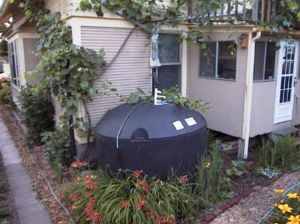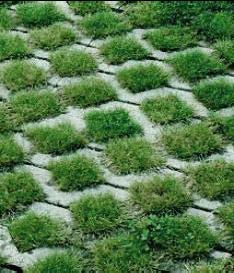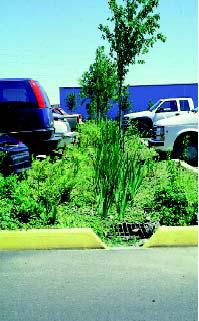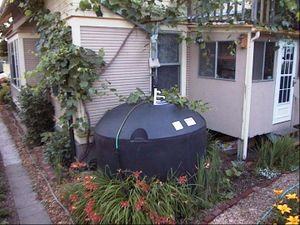

Rain is a vital resource that fills our rivers and replenishes our surface and groundwater supply (see Groundwater recharge). Unfortunately, concrete and other impervious surfaces that make up much of today's (sub)urban landscape interfere with the hydrologic cycle and prevent the natural infiltration process from occurring. Many cities are also plagued with an aging infrastructure and leaky pipes. Municipalities can lose as much as 40 percent of treated water due to faulty pipes and other equipment.[1] This "lost" water exacerbates water shortages and can lead communities to invest in costly new water infrastructure (e.g., dams and river diversions). Communities such as Holliston, Massachusetts are planning to maximize green space for water recharge and are developing wastewater management systems that return high levels of treated water back to the community for local use rather than piping effluent 50 to 100 miles to an upstream town for treatment.[2]
In addition, communities can utilize model ordinances to create stream buffers; street, schoolyard and parking lot designs; and residential landscape recommendations to increase the portion of rainfall that is absorbed and replenishes groundwater supplies. When communities maximize their infiltration potential, they can reduce their reliance on traditional water infrastructure mechanisms, such as dams. A 2002 report by American Rivers, Natural Resources Defense Council and Smart Growth America entitled Paving Our Way to Water Shortages[3] recommends the following:
- Allocate more resources to identify and protect open space and critical aquatic areas;
- Practice sound growth management by passing stronger, more comprehensive legislation that includes incentives for smart growth[4] and designated growth areas;
- Integrate water supply into planning efforts by coordinating road building and other construction projects with water resource management activities;
- Invest in existing communities by rehabilitating infrastructure before building anew – a "fix it first" strategy of development;
- Encourage compact development that mixes retail, commercial and residential development;
- Replace concrete sewer and tunnel infrastructure — which convey stormwater too swiftly into waterways — with low-impact development techniques that replenish groundwater. These include onsite storage that allows the water to infiltrate permeable native soils or bioengineering techniques that facilitate evaporation and transpiration of stormwater; and
- Devote more money and time to research and analysis of the impact of development on water resources, and make this information accessible to the public.
Advantages[edit | edit source]

By carefully considering how to design communities sustainably and how to better plan for future growth and development, municipalities can implement innovative techniques that could extend the life of their water supply (i.e., sustain groundwater aquifers and steady base flows for rivers) and reduce their reliance on water supply dams and river diversions.
Disadvantages[edit | edit source]
Determining the exact amount of groundwater and/or instream flow that can be recouped through wise planning is difficult given the variability in topographical and geological characteristics of landscapes. Many municipalities obtain water from watersheds other than their own. Even if such towns were to integrate smart growth measures into all future urban planning, this might have only limited impact on their water supply and could have a lesser effect on determining whether to remove an existing water supply dam or eliminate the need for a future dam.
Costs[edit | edit source]
Costs can vary widely depending on the type of project undertaken. For example, potential water savings from repairing leaks can be significant, but project costs depend on the extent of the problem and, often, geographic location. However, the estimates below on various pipe repair costs pulled together by the city of Olympia, Washington can serve as a rough example of potential expenditures.[5]
- Repair service leak (3/4" - 1"): $250
- Install service (meter) on a 3/4"-1" line: $600
- Install small main (2" line): $20 per linear foot
- Install 6" or larger main: $50 per linear foot
- Main line valve installation and replacement: $3,750
- Main line (2" - 8" line) leak repair: $600
Costs will also vary for some of the urban planning recommendations referenced above. However, the Center for Watershed Protection has produced a fact sheet that averages the costs for many of the urban planning projects discussed above, included are:[6]
- Bioretention areas: $6.40/cubic foot
- Narrower residential streets: $15/square yard (savings of $35,000/mile of residential street)
- Open space developments: $800/home (infrastructure construction cost savings)[7]
- Wetlands: $289,000 for a ten acrefoot facility
- Porous pavement: $2-3/square foot ($45,000-100,000 per impervious acre)
Urban Design and infrastructure, case study #1[edit | edit source]
Over the past several years, the Center for Watershed Protection has organized a number of local site-planning roundtables in the Mid-Atlantic region. In the late 1990s, they convened a group of development, environmental, local government, civic, non-profit, business and other community professionals as the Frederick County (Maryland) Site Planning Roundtable. Over the course of nine months, the group developed a series of model ordinances that would be used to steer the community toward more sound development practices that take watershed protection into account. The planning group examined issues dealing with stormwater management, impervious cover and preservation of green space. Recommendations put forth by the group, include:
- Shorter, narrower streets
- Fewer and smaller cul-de-sacs
- Smaller parking lots
- Increased stormwater infiltration/on-site capture and treatment
- More community open space
- Flexible sidewalk standards
- Increased vegetated buffers
- Enhanced native vegetation
- Limited clearing and grading
For more information on the Frederick County Site Planning Roundtable and to view a full copy of the report, contact the Center for Watershed Protection at 410-461-8323, via email at center@cwp.org, or visit http://web.archive.org/web/20071011133944/http://www.cwp.org//Frederick.pdf.
Urban Design and infrastructure, case study #2[edit | edit source]
For some of the more arid western states, recommendations like increasing vegetated buffers are often counter-intuitive. However, western states can implement some of the smart growth techniques referenced above to increase infiltration. For example, the Greater Wasatch Area of Utah has embarked on an ambitious strategy, known as Envision Utah, for future growth in the region. This area of northern Utah consists of 88 cities and towns, and is home to 1.7 million people, comprising 80 percent of the state's population.
The number of people living in the Greater Wasatch Area is expected to reach 2.7 million by 2020 and 5 million by 2050. Envision Utah aims to conserve and maintain the availability of the region's water resources by changing land use and increasing the rate of conservation. In addition to utilizing conservation water rates and offering incentives for the use of water-saving appliances, Envision Utah is also working with municipalities to encourage low-irrigation landscaping and drought-resistant plants; offering density bonuses to developers for building affordable housing and for creating walkable neighborhoods; using smaller land lots for building; preserving open space and creating greenways. Envision Utah plans to reduce water usage from the current 319 gallons per household per day to 267 gallons per household per day. Studies indicate that these measures will reduce water infrastructure costs from $2.629 billion to $2.087 billion, which is a savings of $542 million per year. One of the main reasons for undertaking these measures as stated in Envision Utah's strategic plan is to reduce the need for dams and other new diversions.[8]
For more information on Envision Utah and to view a full copy of the report, contact Ted Knowlton of Envision Utah at 801-303-1458, via email at tknowlton@cuf-envision.org or visit http://www.envisionutah.org.
Urban Design and infrastructure, case study #3[edit | edit source]
TreePeople, a non-profit group, helped sponsor a watershed "makeover plan" for the greater Los Angeles basin that, if fully implemented, would cut water imports by up to 50 percent, reduce flooding and create up to 50,000 jobs. In 1997, TreePeople brought together dozens of urban planners, landscape architects, engineers, urban foresters and public agencies to devise the best management practices and a plan of action for the Los Angeles watershed. An example of a project already under way is Broadous Elementary School in the Los Angeles River watershed now collects all of its rainwater on site rather than it becoming runoff and is a living laboratory for the concept behind the bigger citywide plan. A team that included TreePeople, the school district, the Department of Water and Power and others, devised a comprehensive plan to reduce the school's flooding problems. More than 30 percent of the asphalt was removed from the schoolyard and replaced with landscaped areas sloped to catch runoff from remaining hard surfaces. The green area sits atop a state-of-the-art "infiltrator" system, which can store up to 93,000 gallons of rainfall until it is absorbed into the soil, where it replenishes groundwater. Some 220 new trees at the school also help intercept rainfall and slow runoff. The school's lawn now stores and provides more water than is required to maintain it. TreePeople's goal is to implement watershed techniques at the 400 Los Angeles schools being repaved under a school repair bond.
For more information on TreePeople's urban watershed work, visit https://www.treepeople.org/trees/.
Where you can go for help[edit | edit source]
- For more information, contact your state natural resources agency, such as Department of Natural Resources or Department of Environmental Protection.
- Center for Watershed Protection: http://www.cwp.org/.
- The Stormwater Manager's Resource Center: http://www.stormwatercenter.net.
- Nonpoint Education for Municipal Officials, University of Connecticut: http://www.nemo.uconn.edu.
- Natural Resources Defense Council, Stormwater Strategies: http://www.nrdc.org/water/pollution/storm/stoinx.asp.
- American Rivers, Natural Resources Defense Council, Smart Growth America, Paving Our Way to Water Shortages: How Sprawl Aggravates the Effects of Drought: http://web.archive.org/web/20080827165646/http://www.amrivers.org./landuse/sprawldroughtreport.htm.
- Environmental Protection Agency, Menu of Best Management Practices for Stormwater Phase II: http://web.archive.org/web/20060207045240/http://cfpub.epa.gov:80/npdes/stormwater/menuofbmps/menu.cfm.
- Sustainable Builder Sourcebook: http://www.greenbuilder.com/sourcebook/Rainwater.html.
- California Urban Water Conservation Council: http://www.cuwcc.org.
- King County (WA) Department of Natural Resources, Stormwater Topics.
Rainwater harvesting[edit | edit source]
Though its roots are thousands of years old, rainwater harvesting is beginning to be used again in the United States. Harvesting rainwater involves the practice of collecting rain from roofs and other surfaces and storing it in cisterns[9] for later use. In residential and small commercial settings, it can be an economical and environmentally sound option to traditional water supply systems. Constructing a rainwater harvesting system can be a simple or complex endeavor. Water can be collected in a barrel directly from a roof to be used for keeping lawns green, or it can be passed through a series of filters to be used for drinking water.[10]
Advantages[edit | edit source]
While rainwater harvesting alone may not replace or eliminate the need for a water supply dam, it is a good method for conserving water, as well as a good example of the kinds of techniques state and local governments can build into water conservation programs. In regions like the Eastern United States that receive regular rainfall, rainwater harvesting could represent a legitimate alternative to a water supply or irrigation dam. According to the March 2003 issue of New Scientist, the UN Environment Programme (UNEP) is launching an initiative to get Asian governments to invest in rainwater harvesting. A UNEP representative has been quoted as saying that cities in Asia could get at least one-third of their water from these types of systems. This would help up to two billion people in Asia, equaling the capacity of the Three Gorges Dam project in China, which will be the world's largest dam (stretching nearly a mile across and towering 575 feet with a reservoir that would stretch over 350 miles upstream) when completed. Other benefits to rainwater harvesting include decreasing the amount of stormwater runoff thereby reducing the risk of flooding and erosion of urban creeks and preventing polluted runoff from contaminating local water supplies.
Disadvantages[edit | edit source]
The biggest disadvantage to utilizing a rainwater-harvesting unit is the maintenance required. If not correctly utilized and maintained, or if the water is not properly treated, there could be health impacts if the water is used directly for drinking water.[10]In addition, rainwater catchments are likely breeding sites for mosquitoes if not well-screened or otherwise sealed.
Costs[edit | edit source]
Costs and savings vary depending on what function the rainwater harvesting system serves. In areas with sufficient rainfall and no municipal water source, rainwater harvesting systems are often more cost effective than traditional wells. The cost of operating and maintaining a well is estimated to be as much as $120 per month compared to the average one-time cost of $250 to $2,000 for a rainwater harvesting system of comparable capacity. Consumers in Atlanta, for example, could realize savings of up to $200 per year by collecting rainwater to use for landscaping and irrigating their lawns.[11] However, in the United States, it can take more than 30 years to realize savings using a "stand alone" system where municipal water is readily available.[12] For the most economical results, experts recommend maximizing storage capacity in your rainwater harvesting system, practicing water conservation, and using a municipal supply source for drinking water.[10]

Rainwater harvesting, case study[edit | edit source]
The rainwater catchment unit pictured here was installed in January 1996. It was initially installed for non-potable use, but then the city of Portland, Oregon granted approval for a rainwater harvesting and purification system that could be used for all household purposes. Because the system provides drinking water as well, periodic testing is conducted for fecal coliform and other contaminants. The components of the purification system take up about six square feet of floor space, and the entire system costs less than $1,500, though the user incurs additional costs for periodic filter replacement. With Portland's average annual rainfall of three to four feet, the system captures approximately 27,000 gallons of water per year. One faucet is connected to the city's water and used to supplement rainwater supply during the drier summer months and for occasional cooking and drinking.[13]
For more information on the components of the system or links to setting up a system of your own, visit http://web.archive.org/web/20090401165240/http://ersson.sustainabilitylane.com:80/.
Where you can go for help[edit | edit source]
- For more information, contact your state natural resources agency, such as Department of Environmental Protection.
- Sustainable Building Sourcebook: http://www.greenbuilder.com/sourcebook/Rainwater.html.
- Texas Water Development Board. Texas Guide to Rainwater Harvesting. 1997. Second Edition
- United Nations, Rainwater Harvesting and Utilisation: http://web.archive.org/web/20190819133315/http://www.unep.or.jp:80/ietc/Publications/Urban/UrbanEnv-2/9.asp.
Water tanks from stabilised soil blocks[edit | edit source]
- There are inspiring examples that can guide the future. For example, Makerere University's Faculty of Appropriate Technology operates a rainwater harvesting project that uses water tanks made out of stabilised soil blocks. The university has transferred the technology to a number of organizations in Uganda. In one district, for example, over 700 water tanks have been built for individual homes.[14]
Key design points[edit | edit source]
- Screened inlet to prevent the entry of mosquitoes and debris.
- A first-flush device to minimize the entry of dust and pollutants which have built up in the atmosphere and on the roof.
- Cost is an important consideration. Currently rainwater tanks are being promoted and subsidized in places such as NSW, Australia. However, it is also claimed[verification needed] that this is not a cost-effective use of funds, and water recycling (stormwater recycling or sewage recycling) may be more effective.
- Environmental impact should also be considered. The financial cost mentioned above partly reflects use of resources in building and installing the tanks. What are the most cost-effective options? Can adobe water tanks be made effectively without excessive leakage?[expansion needed]adobe hold water.htm an attempt to answer
See also[edit | edit source]
References and footnotes[edit | edit source]
- ↑ NYCWasteLe$$ Business, The Port Authority of New York and New Jersey at LaGuardia Airport, Water Conservation: Restrooms, October 2001, http://www.nycwasteless.com/gov-bus/Casestudies/lgacase2.htm (24 January 2002).
- ↑ Charles River Watershed Association, Environmental Zoning Project: Sustaining Water Resources in Holliston, http://www.craw.org (17 January 2002).
- ↑ American Rivers, Natural Resources Defense Council, and Smart Growth America. Paving Our Way to Water Shortages: How Sprawl Aggravates the Effects of Drought. Washington, D.C.: American Rivers, 2002.
- ↑ While smart growth has been used many different ways, in this context it is used to refer to ten principles of smart growth put out by Smart Growth America that range from infrastructure investments like roads and sewers to economic incentives to encourage revitalization of existing communities. A full list of the ten principles can be found at http://www.smartgrowthamerica.org.
- ↑ City of Olympia, Washington, 2004-2009 Adopted Capital Expenditures Plan, http://web.archive.org/web/20041029211732/http://www.ci.olympia.wa.us:80/Admin/pdf/2004-2009FinalCFP/5_Water.pdf (18 February 2004).
- ↑ Center for Watershed Protection, Stormwater Manager's Resource Center Fact Sheets, http://www.stormwatercenter.net (3 July 2003).
- ↑ Average infrastructure cost savings when using open space design in developments range from 11 to 66 percent. Additionally, developments that utilize open space design often sell for 5 to 32 percent higher than houses in traditional subdivisions.
- ↑ Envision Utah, Envision Utah Quality Growth Strategy and Technical Review, January 2000, http://web.archive.org/web/20051107091705/http://www.envisionutah.org:80/January2000.pdf (27 May 2003)
- ↑ A vessel or tank of some kind used for storing water.
- ↑ 10.0 10.1 10.2 Todd, Wendy P. and others. Texas Guide to Rainwater Harvesting, 2nd edition. Austin: Texas Water Development Board. 1997.
- ↑ Gigley, Gretchen, The Southface Energy Institute, Rainwater Harvesting http://www.southface.org/home/sfpubs/articles/rainwater.htm (12 December 2001).
- ↑ This is because municipal water suppliers do not charge the full cost of supplying water into their rates, allowing consumers to purchase water at artificially low rates.
- ↑ Experiments in Sustainable Urban Living, Rainwater Harvesting and Purification System, November 2006, (8 Sept. 2001).
- ↑ AFRICA INSIGHT: Let's declare a state of ecological emergency subscription only, but may still be available in Google's cache)
External links[edit | edit source]
- Knoxfield rainwater collection - application of rainwater collection in a house in Knoxfield, in the suburbs of Melbourne, Australia. - Greenlivingpedia
Cost effectiveness studies[edit | edit source]
- Urban Rainwater Tank Cost Effectiveness - Australian study commissioned by the National Water Commission - April 2007.
- Rainwater Tanks vs Desal - NSW report comparing the cost of rainwater tanks with the cost of a desalination plant.
Design ideas[edit | edit source]
- WaterHOG - rainwater tank for urban applications which can be stored in a reasonable sized cavity.
- Rain Barrel Diverter
- Waterwall - rainwater tank for urban applications.
Projects[edit | edit source]
- Innovative Water Solutions, LLC - A rainwater harvesting system and graywater recovery system design and installation firm located in Austin, Texas. We perform installations of rainwater collection systems and greywater reuse systems for residential and commercial projects. We also produce recycled rain barrels.
- Riodell rainwater catchment - Establishing a community garden that could help span the cultural gap between the Latino and Anglo members of their community.
- CCAT rainwater catchment system.[1] More info.
Guides and general information[edit | edit source]
- Rainwater Harvesting and Purification System - A case study is given to understand the basic process of collection and use of rainwater.
- Akash Ganga RWH - A starter site for India-centric RWH information
- Kedia R.W.H. Pattern – innovative methods and success stories
- ochshornDesign - Example and instructions for building system with recycled food-grade barrels
- Rainwater harvesting guide
- Simple Guide to Rainwater Harvesting
- Homeowner's guide to rainfall Instructional website for urban home-based rainwater harvesting
Networks[edit | edit source]
- Harvesth2o.com – online rainwater harvesting community
- Rainwater Harvesting Forum - This is a free and open forum for discussion of rainwater harvesting as alternative source of water for household, garden and rainfed farming needs.
Organizations[edit | edit source]
- International Rainwater Catchment Association (IRCSA) International organization on rainwater harvesting
Unsorted[edit | edit source]
- Rainwater harvesting in India
- Rainwater Harvesting at Texas A&M University Extension
- Rainwaterharvesting.org - Making water everybody's businesss
- Using Rain Barrels for Water Collection
- Rainwater Harvesting systems for Montana
- Harvesting Rainwater for Landscape Use